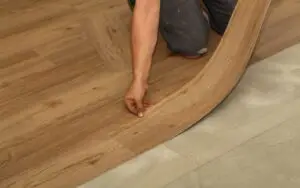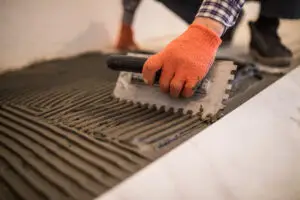What Is Floor Sanding?
Floor sanding is a crucial process for restoring and maintaining the beauty of wooden floors. By removing old finishes, stains, and surface imperfections, sanding prepares the floor for refinishing. This process can significantly enhance a floor’s appearance, prolong its life, and increase property value.
Types of Floor Sanders: An Overview
Drum Sanders
Drum sanders are powerful, heavy-duty tools designed for large-scale projects. They use a rotating drum wrapped with sandpaper to strip away surface layers quickly.
- Best Uses: Ideal for hardwood floors with deep scratches or uneven surfaces.
- Pros: Highly efficient for heavy-duty sanding.
- Cons: Requires skill to avoid creating gouges or uneven areas.
Belt Sanders
Belt sanders use a continuous loop of sandpaper to deliver smooth, consistent sanding.
- Advantages: Easier to control than drum sanders and better for intermediate sanding.
- Disadvantages: Less aggressive than drum sanders, making them slower for large-scale jobs.
Orbital Sanders
Orbital sanders are lightweight and maneuverable tools that move in small, circular patterns.
- Best For: Refinishing projects or light sanding.
- Pros: Easy to use, less likely to damage floors.
- Cons: Not suitable for heavy-duty sanding or removing thick finishes.
Random Orbital Sanders
Random orbital sanders combine rotary and orbital motions for smooth, even sanding.
- Features: Suitable for removing light scratches or prepping floors for finishing.
- Pros: Versatile and beginner-friendly.
- Cons: Slower than drum or belt sanders for large areas.
Edging Sanders
Edging sanders are designed for sanding areas that larger machines cannot reach, such as corners and edges.
- Benefits: Complements other sanders for a complete finish.
- Drawbacks: Limited to edge work and requires pairing with another sander.
Choosing the Right Sander for Your Floor Type
Hardwood Floors
- Recommended Sanders: Drum or belt sanders for deep sanding; orbital or random orbital sanders for refinishing.
- Considerations: Dense wood may require higher grit sandpaper for optimal results.
Engineered Wood Floors
- Sanding Requirements: Use caution with thin veneer layers to prevent damage.
- Best Tools: Random orbital or orbital sanders to minimize surface removal.
Softwood Floors
- Ideal Sanders: Orbital or random orbital sanders for gentle sanding.
- Precautions: Avoid heavy-duty tools like drum sanders to prevent over-sanding.
Factors to Consider When Choosing a Floor Sander
- Project Size: Larger projects benefit from drum or belt sanders, while smaller areas suit orbital sanders.
- Floor Condition: Floors with heavy wear may need aggressive tools, while lightly worn floors require less power.
- Skill Level: Beginners may prefer user-friendly tools like orbital sanders.
- Budget: Renting equipment or hiring professionals might be more economical for specific projects.
How to Use a Floor Sander Safely and Effectively
Preparing the Workspace
- Remove all furniture and rugs from the area.
- Clean the floor thoroughly to remove debris that could damage sandpaper.
Proper Sander Operation
- Start with coarse grit sandpaper and progress to finer grits.
- Keep the sander moving to avoid uneven sanding.
Avoiding Common Mistakes
- Do not skip sanding steps or rush the process.
- Test the sander on a small area before starting the project.
Floor Sanding: DIY or Hire a Professional?
Risks of DIY Floor Sanding
- Equipment Challenges: Operating sanders requires skill and precision.
- Potential Damage: Inexperienced sanding can result in gouges, uneven floors, or damage to floorboards.
Benefits of Hiring Professionals
- Expertise: Professionals know how to handle various floor types and conditions.
- Efficiency: Faster project completion with high-quality results.
- Cost-Effectiveness: Reduces the risk of errors and the need for additional repairs.
FAQs & Answers
Drum sanders are generally the most effective for hardwood floors due to their powerful performance, especially on large, uneven surfaces. However, they require experience to operate smoothly. For smaller or more delicate areas, a belt or orbital sander may be more appropriate. Consulting a professional ensures the right sander is used for your specific floor type.
Yes, you can rent floor sanding equipment from most hardware or home improvement stores. Renting can be cost-effective for small projects, but these machines can be heavy and challenging to operate if you lack experience. For large or intricate jobs, hiring a professional can save time and avoid costly mistakes.
Orbital sanders are excellent for lighter refinishing projects or for removing minor surface imperfections. They are less aggressive than drum or belt sanders, making them a safer choice for thin or delicate flooring. However, they may not be powerful enough for floors with deep scratches or heavy wear.
One of the most common mistakes is leaving the sander in one spot for too long, which can create uneven areas or gouges in the wood. Another issue is failing to sand evenly across the entire floor or skipping finer grit sanding passes. Professionals have the experience to avoid these errors and deliver a smooth finish.
The type of sander you need depends on your floor material, its current condition, and the desired finish. Hardwood floors often benefit from drum or belt sanders, while softer woods or engineered floors require gentler tools like orbital sanders. Consulting with a professional can help you make the best choice for your specific project.
The time required depends on the size of the area, the type of sander used, and the floor's condition. A small room might take a day, while larger projects can extend to several days, including refinishing. Professionals often complete the job faster and more efficiently, thanks to their expertise and high-quality equipment.





